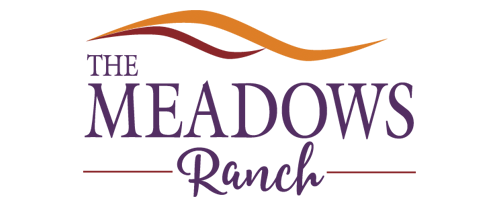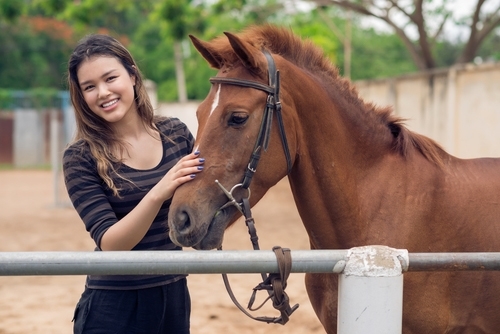“Do you like animals?” she asked. I studied the ground and didn’t answer. I hadn’t found my voice yet and rarely made eye contact. “Have you ever ridden?” I shook my head no. My whole body shook in agreement. Words were no longer necessary. Fear. Isolation. Depression. Anger. Two years into anorexia, my body did the speaking for me. “You know,” the Equine Therapist said, “I think I have the perfect horse for you.”
The next time my family group went to the stables, I was introduced to my horse. Laramie would be my friend and partner while I remained in treatment at The Meadows Ranch. “I think you two will get along well,” the therapist said. “He was abused by his former owners. We rescued him.” She brushed his hair as she talked. “He needs a gentle touch.” She raised my hand to his mane and guided me in a gentle stroke. “He is timid at first. He responds best to a gentle voice.” Her voice was low but tender. She spoke to Laramie the way a mother should speak to a child. “Once he learns to trust you, he’ll be your best friend. Won’t you, old boy?” She rubbed his neck and scratched him behind the ears. “I think you two will learn a lot from each other.”
Though it would be a week or two before I was healthy enough to ride, I began spending time with Laramie. While most of my group went riding, I stayed behind, brushing him down and braiding his hair. I laced ribbons through his mane and patted his sides. I remained silent for a long time; so did Laramie. We were both nervous. I had never spent much time around animals, but as I cared for his body, I began to care about him.
When he whinnied at me or craned his neck to be scratched, I felt wanted. The reward for both of us was almost instant. For Laramie, I was enough. I didn’t need to be someone I wasn’t. Slowly, we began to trust each other. He learned that I would not hurt him. I learned that I could care for him without getting hurt.
As I rubbed his legs, he ruffled a bit. I could feel his nerves rising. “It’s okay, boy.” My voice was quiet at first. I was embarrassed to be talking to a horse, but it was more important to me that he felt safe. I knelt down and massaged his legs some more. I startled when I felt scars. I hadn’t noticed them before. “He was chained up,” the wrangler said. “His owners beat him up pretty bad.” I had forgotten she was standing there. I kept talking to Laramie. “I won’t hurt you,” I said, trying to convince both of us that this was true. These early lessons were pivotal and I had yet to saddle my horse.
After I was cleared to ride, Equine Therapy became one of my favorite activities. Alternating between arena and trail riding, each session taught me something new. Arena riding taught me to communicate. With a squeeze, a tug, or a kick, I directed Laramie around and between barrels. I learned how to read my horse, respond to his needs, and interact effectively. In order to be successful and improve my rides, I learned to practice new skills and ask for help when necessary.
Long trail rides were my favorite. Venturing out into the desert, I learned to enjoy the moment and trust my partner. As we passed the cactus and creosote, I remembered that there was beauty to behold and reasons, big and small, to live. I learned to push through my fear by relying on Laramie’s strength, knowledge, and kindness; trusting him to take me where I needed to go. With time I came to understand that the leaders and residents would never leave me. If I made a mistake, nobody teased or yelled. No matter how slow Laramie and I walked, someone was always by my side.
I loved Equine Therapy and look back on it fondly, but it was not easy. One of my most challenging moments came during a private therapeutic session. I was asked to interlock arms with my Primary Therapist and the Equine Therapist and give them instructions. Working together we would saddle my horse. The two of them would only be allowed to do exactly what I told them to do. The idea terrified me. I did not know how to saddle a horse. What if I asked them to do the wrong thing? What if I made a mistake? What if they laughed at me? I froze.
Unable to talk or feel or get out of my head, I could not move. I learned later that I had dissociated. When it became apparent that I was unable to complete the session, my therapist walked me to her office. We sat for a long time until I was aware enough to listen. She reassured me. “It’s okay,” she said. “I pushed you too much, too early. That was my mistake. I’m sorry.” In my most broken moment, my therapist did not shame me. I began to understand that I could trust her. She modeled healthy sorrow and willingness to seek forgiveness. She reassured me that mistakes are an acceptable part of learning and expected part of growth. I realized how difficult it was for me to need and accept help. My therapist taught me that accepting help would be necessary if I wanted to heal. My “failed” session was a success—an eye-opening moment in my journey toward health and healing.
Though my time with Laramie ended when I left the ranch, I keep a picture of him on my dresser and think of him daily. Whether on the trail, in the arena, or at the stables, he was an essential part of my healing. He was the partner I did not know I needed, the friend who taught me to feel again.

